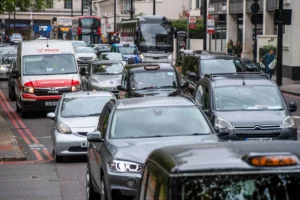In 2023, traffic congestion continued to be a significant issue in many cities around the world. The capitals of Peru and Mexico being notable examples.
According to TomTom’s data, Mexico City and Lima were among the top three cities globally for the amount of time their residents spent in traffic jams.
Mexico City ranked third, with its residents losing 152 hours in traffic congestion. Lima was second, with 157 hours lost in traffic during the year.
Dublin, Ireland, topped the list with 158 hours. This data reflects a broader global challenge of traffic congestion.
For instance, London was identified as the world’s slowest city in terms of traffic. Drivers lose a significant amount of time even under optimal traffic conditions.

In London, a 10-kilometer trip takes about 25 minutes in the best conditions—traffic costs drivers over 12 minutes every 10 kilometers on average.
This is in stark contrast to cities like Tokyo, where drivers lose only six minutes to traffic congestion for the same distance.
Interestingly, Mexico City presents a unique case. Under optimal traffic conditions, a 10-kilometer drive across Mexico City takes just about 14 minutes and 25 seconds.
However, with traffic, that journey time increases to an average of 26 minutes and 30 seconds. Resulting in significant time lost to traffic.
Mexico City is second after London in terms of time lost to traffic, but in terms of average travel time, it’s the 15th slowest city globally.
In contrast, several American cities manage traffic effectively.
Cities like Dayton and Akron in Ohio and Albany and Syracuse in New York see drivers lose very little time to traffic.
The infrastructure in these cities, particularly the large highways running through them, contributes to higher average speeds and less congestion.
TomTom’s VP of Product Management of Traffic, Travel, and Routing, Ralf-Peter Schäfer, suggests that the solution to congestion lies beyond just managing car traffic.
He highlights the examples of Amsterdam and Copenhagen, where road demand has shifted to bike and pedestrian traffic, reducing congestion significantly.
This approach emphasizes the importance of considering various modes of transport and urban planning in managing city traffic.
Overall, the TomTom Traffic Index data provides valuable insights into the challenges and solutions for traffic congestion in cities worldwide.
It underscores the need for comprehensive traffic management strategies that go beyond conventional approaches, focusing on sustainable, multimodal solutions.

